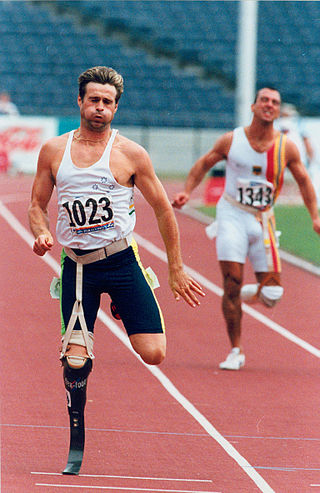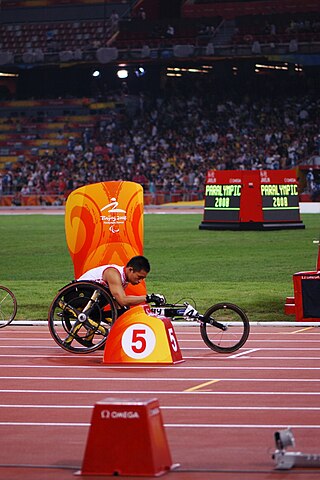F31 is a disability sport classification for seated throwing events (the "F" stands for field events, excluding jump events) in disability athletics. The only event this class competes in at the Paralympic Games is the club throw.
This classification is for disability athletics. [1] The Australian Paralympic Committee defines this classification as being for "Severe quadriplegia " [2]
The classification was created by the International Paralympic Committee and has roots in a 2003 attempt to address "the overall objective to support and co-ordinate the ongoing development of accurate, reliable, consistent and credible sport focused classification systems and their implementation." [3]
Athletes in this class used secure frames for throwing events. The frame can be only one of two shapes: A rectangle or square. The sides must be at least 30 centimetres (12 in) long. The seat needs to be lower at the back or level, and it cannot be taller than 75 centimetres (30 in). This height includes any cushioning or padding. [4] Throwers can have footplates on their frames, but the footplate can only be used for stability. It cannot be used to push off from. Rests can be used on the frame but they need to be present only for safety reasons and to aide in athlete stability. They need to be manufactured from rigid materials that do not move. These materials may include steel or aluminum. The backrest can have cushioning but it cannot be thicker than 5 centimetres (2.0 in). It cannot have any movable parts. The frame can also have a holding bar. The holding bar needs to be round or square, and needs to be a single straight piece. Athletes are not required to use a holding bar during their throw, and they can hold on to any part of the frame during their throw. [4] Throwing frames should be inspected prior to the event. This should be done either in the call room or in the competition area. [4] In general, people in this class should be allocated around 3 minutes to set up their chair. [4]
Athletes need to throw from a seated position. They cannot throw from an inclined or other position. Doing so could increase the contribution of their legs and benefit their performance. Their legs must be in contact with the seat during the throw. If an athlete throws from a non-seated position, this is counted as a foul. [4] People in this class cannot put tape on their hands. [4] All straps used to hold the athlete to the frame must be non-elastic. While in the process of throwing, an athlete cannot touch a tie-down for the frame. Because of visibility issues for officials, athletes cannot wear lose clothing and they can ask athletes to tuck in clothing if they feel there is any issue with visibility. In throwing events at the World Championships, athletes get three initial throws. After that, the top 8 throwers get an additional three throws. For other events, organizers generally have the option to use that formula or to give all throwers six consecutive throws. [4]
Athletes with cerebral palsy or similar impairments who wish to compete in para-athletics competition must first undergo a classification assessment. During this, they both undergo a bench test of muscle coordination and demonstrate their skills in athletics, such as pushing a racing wheelchair and throwing. A determination is then made as to what classification an athlete should compete in. Classifications may be Confirmed or Review status. For athletes who do not have access to a full classification panel, Provisional classification is available; this is a temporary Review classification, considered an indication of class only, and generally used only in lower levels of competition. [5]
| gender | EVENT | Class | AQS/MQS | BQS | Event |
| men's | club throw | F31/32 | 32.57 | 29.75 | 2016 Summer Paralympics [6] |
| women's | club throw | F31/32 | 20.85 | 17.5 | 2016 Summer Paralympics [6] |

The Summer Paralympics, also known as the Games of the Paralympiad, are an international multi-sport event where athletes with physical disabilities compete. This includes athletes with mobility disabilities, amputations, blindness, and cerebral palsy. The Paralympic Games are held every four years, organized by the International Paralympic Committee. Medals are awarded in every event, with gold medals for first place, silver for second and bronze for third, a tradition that the Olympic Games started in 1904.
T38 and CP8 are disability sport classification for disability athletics intended for people with cerebral palsy. It includes people who have coordination impairments such as hypertonia, ataxia and athetosis. Runners in this class may appear to have a slight limp when they are running but otherwise have a stride similar to able-bodied runners. Events for this class include 100 meters, 400 meters, 1,500 meters, and the long jump.
T32 is disability sport classification for track events in disability athletics. This is a wheelchair racing class. The classification is one of three classes of wheelchair racing for people with athetosis, ataxia or hypertonia. The number of events available to people in this class has decreased since the 1980s, with no T32 events at the 2016 Summer Paralympics. While undergoing classification, T32 competitors both undergo a bench test of muscle coordination and demonstrate their skills in athletics.
T33 and CP3 are disability sport classification for disability athletics. The class competes using a wheelchair. The classification is one of eight for people with cerebral palsy, and one of four for people with cerebral palsy who use a wheelchair. Athletes in this class have moderate quadriplegia, and difficulty with forward trunk movement. They also may have hypertonia, ataxia and athetosis.
T34 is a disability sport classification for disability athletics. The classification is one of eight specifically for athletes with cerebral palsy, and one of four for athletes with cerebral palsy who use a wheelchair. People in this class have hypertonia, ataxia and athetosis. This class includes people who have cerebral palsy, or who have had a stroke or traumatic brain injury.
T35 is a disability sport classification for disability athletics' running competitions. It includes people who have coordination impairments such as hypertonia, ataxia and athetosis. This includes people with cerebral palsy. The classification is used at the Paralympic Games. The corresponding F35 classification includes club and discus throw, shot put, and javelin.
T36 is a disability sport classification for disability athletics. It includes people who have coordination impairments such as hypertonia, ataxia and athetosis. It includes people with cerebral palsy. T36 is used by the International Paralympic Committee. This classification competes at the Paralympic Games.

T37 is a disability sport classification for disability athletics in track and jump events. It includes people who have coordination impairments such as hypertonia, ataxia and athetosis. It is the athletics equivalent of the more general CP7 classification.
T42 is a disability sport classification for disability athletics, applying to athletes with single above the knee amputations or a disability that is comparable. This class includes ISOD classified A2 and A9 competitors.

T44 is a disability sport classification for disability athletics, applying to "Single below knee amputation or an athlete who can walk with moderately reduced function in one or both legs." It includes ISOD A4 and A9 classes.

T45 is disability sport classification in disability athletics for people with double above or below the elbow amputations, or a similar disability. The class includes people who are ISOD classes A5 and A7. The nature of the disability of people in this class can make them prone to overuse injuries. The classification process to be included in this class has four parts: a medical exam, observation during training, observation during competition and then being classified into this class.

T46 and F46 are disability sport classification for disability athletics. People in this class have a single below or above the elbow amputation. The amputee sports equivalent class is ISOD the A6 and A8 classes. People in this class can have injuries as a result of over use of their remaining upper limb. The classification process to be included in this class has four parts: a medical exam, observation during training, observation during competition and then being classified into this class.
T51 is disability sport classification for athletics. The class includes people with a number of different types of disabilities including spinal cord injuries and cerebral palsy. Similar classifications are T52, T53, T54 and T55. It is for sportspeople with minimal upper body function who use a wheelchair, spinal cord injury class F1 and Les Autres class LAF1.
T52 is disability sport classification for disability athletics. People in this class have good shoulder and upper body control, but lack fine motor skills in their arms and hands. They have no or limited trunk and leg function. The class includes people with a number of different types of disabilities including spinal cord injuries. Similar classifications are T51, T53 and T54.

T54 is a disability sport classification for disability athletics in the track and jump events. The class includes people with spinal cord injuries who compete using a wheelchair in track events. They have paraplegia, but have normal hand and arm function, normal or limited trunk function, and no leg function. This class includes CP-ISRA classes CP3 and CP4, and some athletes in ISOD classes A1, A2 and A3.

T53 is disability sport classification for disability athletics. The class includes people with a number of different types of disabilities including spinal cord injuries. People in this class have full use of their arms but have no or limited trunk function. Similar classifications are T51, T52, and T54. People in this class have a functional upper limbs, but limited trunk usage and limited lower limb functionality. During classification, they both undergo a bench test of muscle strength and demonstrate their skills in athletics. People in this class include Tanni Grey-Thompson (GBR), Samantha Kinghorn (GBR), Angie Ballard (AUS) and Richard Colman (AUS).
F57 is a disability sport classification for disability athletics for people who compete in field events from a seated position. This class is for people with limb deficiencies not covered by other classes. It includes people who are members of the ISOD A1 and A9 classes. Events open to people in this class include the shot put, discus and javelin.
F56 is a disability sport classification for disability athletics for people who compete in field events from a seated position. The seating field event class used to be known as lower 4, upper 5. Different disability groups compete in this class, including people with amputations and spinal cord injuries. Events that may be on the program for F56 competitors include the discus throw, shot put and javelin.
F55 is a disability sport classification for disability athletics for people who compete in field events from a seated position. Sportspeople in this class have full arm function, partial trunk function and no lower limb function. Different disability groups compete in this class, including people with spinal cord injuries. The classification was previously known as lower 3, upper 4.
F54 is a disability sport classification for disability athletics for people who compete in field events from a seated position. Different disability groups compete in this class, including people with spinal cord injuries. Events that may be on the program for F54 competitors include the discus throw, shot put and javelin.
{{cite web}}: Missing or empty |url= (help)